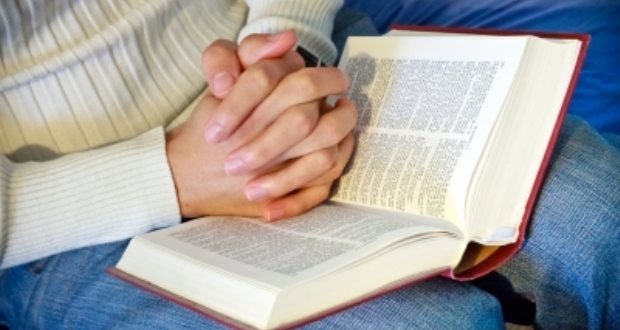Catechism Of The Catholic Church – The Interpretation of the Heritage of Faith

PART ONE: THE PROFESSION OF FAITH
SECTION ONE “I BELIEVE” – “WE BELIEVE”
CHAPTER TWO – GOD COMES TO MEET MAN
Article 2
III. The Interpretation of the Heritage of Faith
The heritage of faith entrusted to the whole of the Church
84 The apostles entrusted the “Sacred deposit” of the faith (the depositum fidei),45 contained in Sacred Scripture and Tradition, to the whole of the Church. “By adhering to [this heritage] the entire holy people, united to its pastors, remains always faithful to the teaching of the apostles, to the brotherhood, to the breaking of bread and the prayers. So, in maintaining, practising and professing the faith that has been handed on, there should be a remarkable harmony between the bishops and the faithful.”46
The Magisterium of the Church
85 “The task of giving an authentic interpretation of the Word of God, whether in its written form or in the form of Tradition, has been entrusted to the living teaching office of the Church alone. Its authority in this matter is exercised in the name of Jesus Christ.”47 This means that the task of interpretation has been entrusted to the bishops in communion with the successor of Peter, the Bishop of Rome.
86 “Yet this Magisterium is not superior to the Word of God, but is its servant. It teaches only what has been handed on to it. At the divine command and with the help of the Holy Spirit, it listens to this devotedly, guards it with dedication and expounds it faithfully. All that it proposes for belief as being divinely revealed is drawn from this single deposit of faith.”48
87 Mindful of Christ’s words to his apostles: “He who hears you, hears me”,49 The faithful receive with docility the teachings and directives that their pastors give them in different forms.
The dogmas of the faith
88 The Church’s Magisterium exercises the authority it holds from Christ to the fullest extent when it defines dogmas, that is, when it proposes truths contained in divine Revelation or also when it proposes in a definitive way truths having a necessary connection with them.
89 There is an organic connection between our spiritual life and the dogmas. Dogmas are lights along the path of faith; they illuminate it and make it secure. Conversely, if our life is upright, our intellect and heart will be open to welcome the light shed by the dogmas of faith.50
90 The mutual connections between dogmas, and their coherence, can be found in the whole of the Revelation of the mystery of Christ.51 “In Catholic doctrine there exists an order or hierarchy 234 of truths, since they vary in their relation to the foundation of the Christian faith.”52
The supernatural sense of faith
91 All the faithful share in understanding and handing on revealed truth. They have received the anointing of the Holy Spirit, who instructs them53 and guides them into all truth.54
92 “The whole body of the faithful. . . cannot err in matters of belief. This characteristic is shown in the supernatural appreciation of faith (sensus fidei) on the part of the whole people, when, from the bishops to the last of the faithful, they manifest a universal consent in matters of faith and morals.”55
93 “By this appreciation of the faith, aroused and sustained by the Spirit of truth, the People of God, guided by the sacred teaching authority (Magisterium),. . . receives. . . the faith, once for all delivered to the saints. . . the People unfailingly adheres to this faith, penetrates it more deeply with right judgment, and applies it more fully in daily life.”56
Growth in understanding the faith
94 Thanks to the assistance of the Holy Spirit, the understanding of both the realities and the words of the heritage of faith is able to grow in the life of the Church:
– “through the contemplation and study of believers who ponder these things in their hearts”;57 it is in particular “theological research [which] deepens knowledge of revealed truth”.58
– “from the intimate sense of spiritual realities which [believers] experience”,59 The sacred Scriptures “grow with the one who reads them.”60
– “from the preaching of those who have received, along with their right of succession in the episcopate, the sure charism of truth”.61
95 “It is clear therefore that, in the supremely wise arrangement of God, sacred Tradition, Sacred Scripture and the Magisterium of the Church are so connected and associated that one of them cannot stand without the others. Working together, each in its own way, under the action of the one Holy Spirit, they all contribute effectively to the salvation of souls.”62
45 DV 10 # 1; cf.I Tim 6:20; 2 Tim 1:12-14(Vulg.).
46 DV 10 # 1; cf. Acts 2:42 (Greek); Pius XII, Apost. Const.
Munificentissimus Deus, 1 November 1950: AAS 42 (1950), 756, taken along
with the words of St. Cyprian, Epist. 66, 8: CSEL 3/2, 733: “The Church
is the people united to its Priests, the flock adhering to its Shepherd.”
47 DV 10 # 2.
48 DV 10 para 2.
49 ⇒ Lk 10:16; cf. LG 20.
50 Cf.⇒ Jn 8:31-32.
51 Cf. Vatican Council I: DS 3016: nexus mysteriorum; LC 25.
52 UR II.
54 Cf. . ⇒ Jn 16:13
55 LG 12; cf. St. Augustine, De praed. sanct. 14, 27: PL 44, 980.
56 LG 12; cf. Jude 3.
57 DV 8 # 2; cf. ⇒ Lk 2:19, ⇒ 51
58 GS 62 # 7; cf. GS 44 # 2; DV 23; 24; UR 4.
59 DV 8 # 2.
60 DV 8 # 2.
61 St. Gregory the Great, Hom. in ⇒ Ezek. 1, 7, 8: PL 76, 843D.
62 DV 10 # 3.
![]()


